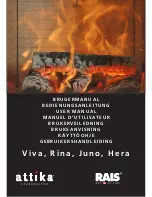
Operating Instructions
1. Open tank cap and fill with kerosene to just below top, using fill bottle. Tank capacity is
950ml (32 oz). You can also use Mineral Spirits from a hardware or paint store or Jet-A
fuel from an airport. Never use gasoline or other camp stove fuels.
2. Tighten cap and loosen vent next to cap.
3. Clean burner nozzle tip occasionally with provided wire pick as needed.
4. Unlock gimbal for use at sea by removing the locking bolts in U-bracket.
5. Place cooking pot on stove with water or cooking ingredients in pot so as not to burn an
empty pot. At sea, adjust pan clamps to fit small pots by spiraling them inward.
6. Preheat stove by dipping preheat wick in bottle of denatured alcohol and clip wick under
burner above preheat bowl. Close bottle top. Light wick with butane lighter. (Lacking a
wick, preheat bowl can be filled with alcohol and lit. You can also preheat with high-proof
rum. Lacking alcohol, preheat with kerosene, setting stove in cockpit due to smoke.)
7. Once preheat flame has nearly burnt itself out after about 90 seconds, close tank vent by
turning vent knob fully clockwise and pump the stove two to three pumps. Immediately
light burner with a butane lighter. Wick can be left clipped under burner.
8. Pump more for higher flame. Momentarily loosen vent knob for lower flame.
9. Swing lead counterweight outboard to compensate for the weight of a frying pan handle
when using with unlocked gimbal. Lead weight locks in position with a wing nut.
10.
To shut off stove, loosen tank vent. Do
not
retighten vent until next use.
Additional Notes and Troubleshooting:
To operate a pressure kerosene stove successfully you must follow a simple methodical
operating procedure and learn some basic troubleshooting.
1.
When
pumping stove
, support tank from behind with one hand. At sea when the gimbal
is unlocked you may secure smaller pots with the three
pan clamps
if a heavy sea is
running. When cooking ashore or anytime the stove is unsecured, use extreme caution to
avoid spilling a hot cooking pot on yourself.
2.
For kerosene to burn without smoke or odor, it must be
vaporized by a hot burner
preheated with denatured alcohol. Once stove is operating, heat from the burner flame
itself keeps the burner hot enough to vaporize the kerosene. To ensure proper preheating,
place your pot on top of stove before lighting the preheat wick. This prevents drafts from
cooling the burner, gets you started cooking with the preheat flame and prevents scorching
the boat’s overhead. If the stove emits black smoke the burner was not preheated enough
or it was allowed to cool during operation. This can happen by leaving the flame extremely
low for a long time or by a wind blowing across the burner. If this happens, release the
pressure and allow burner to cool one minute. Begin again by preheating with alcohol.
Whenever a sooty flare-up of the flame occurs, release pressure, let cool, clean nozzle with
pick and start over by preheating with alcohol.
3.
There are
three types of kerosene burners
. The Atom Stove burner is called a “roarer”
because of its relatively loud hissing noise, which is useful because its volume tells you if
flame is on high or low without requiring that you visually monitor it. The second type is
the “silent” burner, which although having the questionable advantage of less noise, also
has a lower tolerance for blowouts by wind. Even the roarer burner cannot take too much
direct wind so you may need to set up a temporary windbreak next to the stove at times
or partially close a hatch. The third type is a silent burner that has an adjustment knob on
the side to regulate the flame instead of using the pump and vent knob for regulation. This
burner has more parts to maintain and prone to valve leaks.
4.
Although
preheating stove
can be done by squirting alcohol from a plastic bottle into
burner’s preheat bowl, the provided preheat wick is safer and easier. Fill the supplied
plastic jar with alcohol and dip the wick into it until fully saturated. Always close jar lid
before lighting wick. Keep a hatch open during preheat to reduce alcohol fumes eye-
2





















